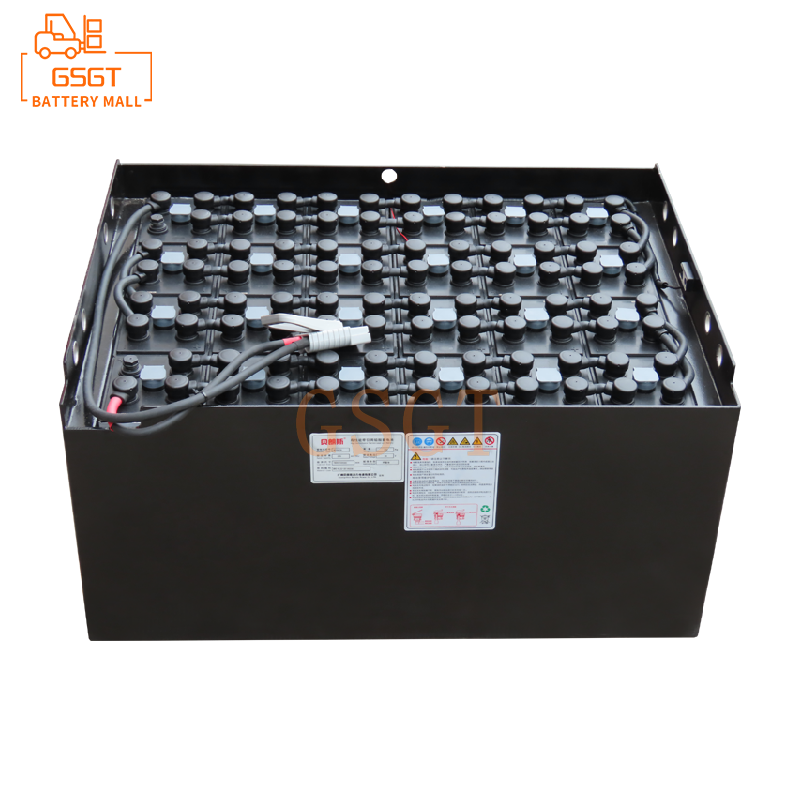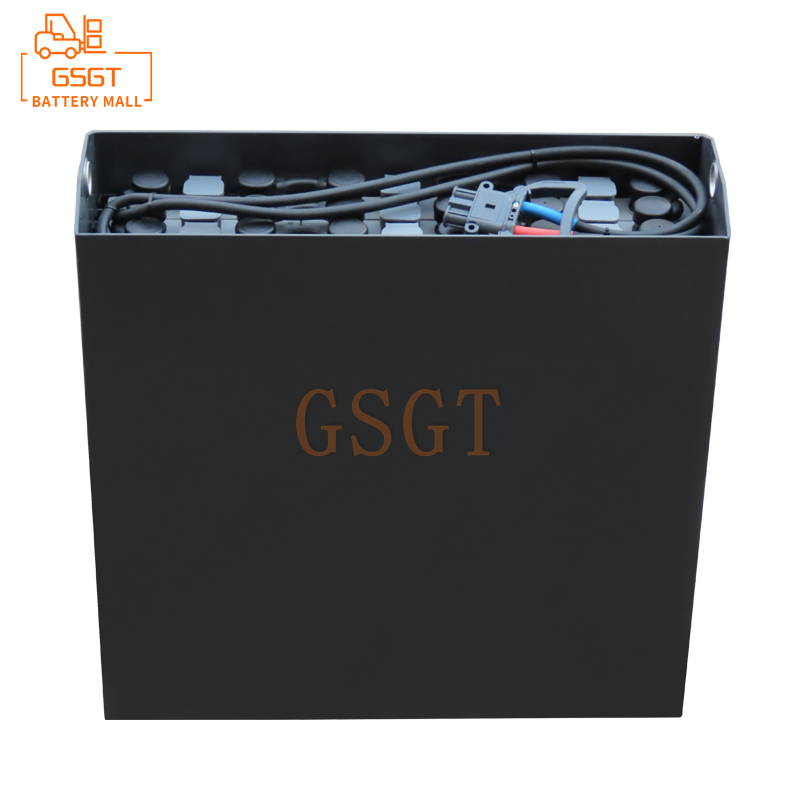Time:2025-07-18 09:59:38
Browse:617
In modern logistics and industrial production, as an important handling equipment, the power source of forklifts is of vital importance. Lead-acid batteries have become a commonly used power source for forklifts due to their mature technology and low cost. Understanding the basic knowledge points of lead-acid batteries for forklifts is of great significance for the efficient operation of forklifts, maintenance and care, as well as extending the service life of the batteries.
1. Structure of Lead-Acid Batteries for Forklifts
Lead-acid batteries are mainly composed of plates, separators, electrolyte, casings, connecting bars and terminals, etc.
Plates: As the core component of a storage battery, they are composed of grid frames and active materials. The grid frame is generally cast from lead-antimony alloy. Adding antimony can enhance mechanical strength and casting performance. The active substances are mainly made by mixing lead powder, additives and dilute sulfuric acid of a specific density. The plates are further divided into positive plates and negative plates, during which crucial electrochemical reactions occur during charging and discharging.
Separator: Its function is to prevent adjacent positive and negative plates from coming into contact with each other and causing a short circuit. Therefore, a separator is needed to separate the positive and negative plates. The materials for making partitions include wood, microporous rubber and microporous plastic, etc.
Electrolyte: It is usually a solution prepared by mixing pure sulfuric acid and distilled water in a certain proportion, and its specific gravity is generally around 1.28. The electrolyte plays a crucial role in the electrochemical reaction of the storage battery and participates in the reaction process of the active substances on the positive and negative plates.
The casing: It is used to hold the electrolyte and the plate group, making the battery form a complete whole. The main shell materials are hard rubber and plastic, which are required to have good insulation and corrosion resistance.
The main function of the connection bar is to connect the single-cell batteries in series, thereby increasing the terminal voltage of the entire battery and meeting the power supply voltage requirements of the forklift.
Terminal posts: On the horizontal plates of the head and tail plate groups of ordinary lead-acid batteries, terminal posts are welded. The common types of terminal posts include conical, L-shaped and side hole types. To facilitate the distinction between the positive and negative terminals, a "+" or "P" symbol is marked on or beside the positive terminal, while a "-" or "N" symbol is marked on the negative terminal.
2. Working Principle of Lead-Acid Batteries for Forklifts
(1) Charging principle
When a lead-acid battery is charged, a series of chemical reactions occur on the positive and negative plates under the action of an external power source. During this process, electrical energy is converted into chemical energy and stored inside the battery. As the concentration of sulfuric acid gradually increases, the battery voltage rises.
(2) Discharge Principle
When a forklift operates with a battery, that is, when the battery discharges externally, the reaction process is opposite to charging. As the discharge proceeds, sulfuric acid reacts with the active substances on the positive and negative plates to form lead sulfate. The concentration of sulfuric acid decreases, the voltage across the battery drops, and the chemical energy is gradually converted into electrical energy for the forklift to use.
3. Performance and Service Life of Lead-Acid Batteries for Forklifts
Performance influencing factors: The performance of a storage battery not only depends on its own structure and quality, but is also closely related to the usage conditions and maintenance quality. For instance, frequent deep discharges, insufficient charging, and excessively high or low ambient temperatures can all have a negative impact on the performance of storage batteries, leading to a decrease in capacity and an increase in internal resistance.
Service life: Under normal usage conditions, the lifespan of lead-acid batteries for forklifts can generally reach about 3 years. However, the actual service life may vary due to various factors. If the correct charging and discharging methods are followed during use and regular maintenance is carried out, such as keeping the battery surface clean, checking the electrolyte level and density, etc., its service life can be effectively prolonged. On the contrary, if not used properly, such as long-term overcharging and overdischarging, it may lead to faults inside the battery such as sulfation of the plates, shedding of active materials, and self-discharge, thereby shortening the battery's lifespan.
4. Frequently Asked Questions
(1) Why does the lead-acid battery of forklifts experience sulfation of the plates?
Plate sulfation refers to the phenomenon where white coarse-grained lead sulfate is formed on the plates, which is simply called "sulfation". The main reason is that the battery is often undercharged, which leads to the lead sulfate on the plates not being fully converted into lead dioxide and spongy lead after discharge. As a result, the lead sulfate gradually crystallizes and grows in the electrolyte. Excessive discharge causes an overproduction of lead sulfate on the plates. Lead sulfate will gradually crystallize if left unused for a long time. This coarse-grained lead sulfate has very poor electrical conductivity. During normal charging, it is difficult to convert into lead dioxide and spongy pure lead. Moreover, it will clog the voids of the active material and hinder the penetration of the electrolyte, resulting in a significant increase in the internal resistance of the battery and a decrease in capacity.
(2) How to determine whether the lead-acid battery of a forklift needs to be replaced?
When the following situations are found in the forklift battery, it may be necessary to consider replacing it: First, the battery capacity drops significantly, and the working time of the forklift is greatly shortened. Even after multiple charges, it cannot be restored to the normal level. Second, the battery heats up severely during charging, and the charging time is significantly prolonged. The third issue is that the battery's appearance shows severe deformation, leakage and other conditions. The fourth is that a short circuit occurs inside the battery, which is manifested as low voltage during charging, low capacity during discharging, and an increase in the temperature of the electrolyte, etc.
(3) What precautions should be taken when charging lead-acid batteries for forklifts?
First of all, the charging area should be well-ventilated because hydrogen is produced during the charging of lead-acid batteries. If the hydrogen concentration is too high in a closed space, there is a risk of explosion. Secondly, before charging, check the appearance of the battery to see if there is any leakage, bulging, damage to the casing, and whether the terminals are corroded or loose. If there is any leakage, first wear gloves and then handle it with baking soda water and acid solution. Do not continue charging. At the same time, make sure that the charger matches the battery model, voltage and capacity, whether the charger cable and plug are damaged, and whether the cooling fan is working properly. When charging, first connect the charger plug to the battery charging interface, and then turn on the power to avoid sparks caused by plugging and unplugging while powered on. After charging is complete, first disconnect the power supply and then unplug the battery end plug. Following the principle of "shallow discharge and frequent charging", lead-acid batteries should be charged in time when their capacity drops below 20%. The single charging time is generally 8 to 10 hours. After full charging, the power should be cut off immediately to avoid overcharging. During the charging process, regularly check if the battery is overheating abnormally (the normal temperature should be below 45℃), if there is any strange smell or smoke. If any abnormality is found, immediately cut off the power and stop charging, and then troubleshoot.
In conclusion, a thorough understanding of the basic knowledge points of lead-acid batteries for forklifts and mastering the correct usage and maintenance methods are of great significance for ensuring the normal operation of forklifts, improving work efficiency, and reducing operating costs.

$1060

$5710

$1690

$1200

MESSAGE
Professional And Efficient
Security
Affordable Price
Professional Services